#Society of American Archivists
Text
Hiring Librarians Podcast S01 E06: Kaetrena Davis Kendrick (Part One of Two)
My guest is Kaetrena Davis Kendrick, whose work on low morale in libraries is lighting some dark corners in the LIS profession. #Libraries #Librarians #renewerslis
My guest is Kaetrena Davis Kendrick, whose work on low morale in libraries is lighting some dark corners in the LIS profession. Her data collection projects and the associated reports are available on her Renewals website, as well as information about her coaching, facilitating and speaking, and consulting services. You can also connect with the community on Bluesky, Facebook, Twitter, and…
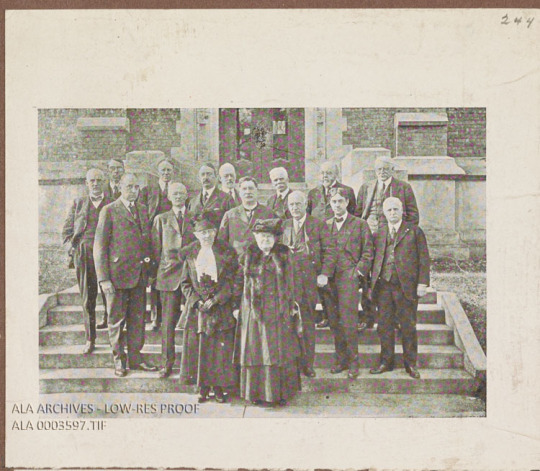
View On WordPress
#Librarian#librarians#libraries#library careers#library hiring#library interview#library jobs#LISCareers#Society of American Archivists
2 notes
·
View notes
Text
"If an item does not appear in our records, it does not exist": Star Wars and archives in popular culture [Part 1]
On the night of March 11, 2019, partially in preparation for the next week's discussion, on March 27th at 8 PM, of the SNAP (Students and New Archives Professionals), a division of the Society of American Archivists (SAA), which will be on "the representation of archives and archivists in popular culture" I watched Star Wars Episode II: Attack of the Clones, a film that came out 17 years ago. The movie itself has the theme of archives throughout at least part of it, as it is a major plot point. I don't wish to tread on the same ground as Samantha Cross, the archivist who combined her passion for pop culture and archives together on POP Archives, who wrote an article about how "two movies in the Star Wars franchise have made use of the archive as an important setting within the narrative" and in doing so "highlighted the importance of archives as institutions of memory and accountability while simultaneously showcasing the shortcomings of archives to protect the people they serve." She also focuses on Rogue One, but I'll talk about that in a later post on here. With that, I'll begin my post in earnest, focusing on the interconnection of archival themes with Star Wars Episode II. All images in this article are used under the fair use exception to U.S. copyright law, as they are used as a means of criticism and education, nothing more.
Reprinted from my Wading Through the Archival Stacks WordPress. Originally posted on Aug. 8, 2020.
The first mention of archives in the film is not when Jedi Master Obi-Wan (played by Ewan McGregor) comes to the archives of the Jedi Temple in Coruscant. Rather it is when he talked to his old friend Dex, who owns a small restaurant, complaining that the analysis droids in the archives were no help in identifying the poison dart fired from a bounty hunter, with Dex telling him it is from the cloners on Kamino:
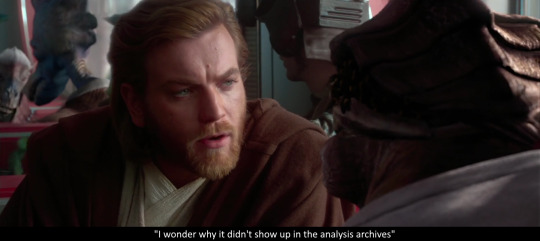

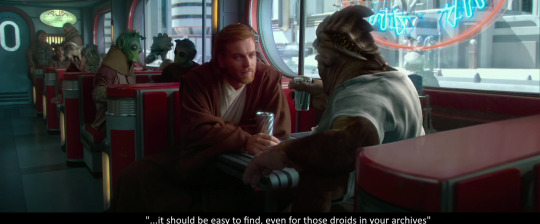
While the photos above are not their whole conversation, the screencaps I show above are the most relevant parts. In fact, there is a deleted scene from the movie, where, according to Wookiepedia (the premier Star Wars encyclopedia), Obi-Wan has "the Kamino saber dart analyzed in the Analysis Rooms in the Jedi Temple," which he considers in some sense to be part of the archives!
© 2022 Burkely Hermann. All rights reserved.
#star wars#attack of the clones#rogue one#samantha cross#society of american archivists#snap#archivists#archives#kamino#coruscant#ewan mcgregor
10 notes
·
View notes
Text
The fate of history in the balance: The Seattle Federal Records Center still under threat
On February 16, John C. Coughenour, a Reagan-appointee and Senior Judge of the U.S. District Court for the Western District of Washington, blocked the sale of the National Archives facility at Seattle, one of the Federal Records Centers (FRC) in the U.S. with a preliminary injunction. This ended the movement of records from the facility to FRCs in Missouri and California, many of which are “un-digitized records.” He called the situation a “public relations disaster” of the Public Buildings Reform Board (PBRB), the entity which proposed the sale, and said that the PBRB had “a stunning lack of appreciation of the issues” of indigenous people. While the attorney generals of Washington State and Oregon applauded the decision, as did indigenous people, genealogists, U.S. Senator Maria Cantwell, and others, the fight is not over. The Stranger said that history “requires defending in the present,” The Cut argued that the fate of the Seattle FRC “remains undecided,” and MyNorthwest noted there is “more potential trouble” in the future if noting about the facility changes going forward. On February 18, local Seattle leaders and the governor of Oregon both wrote President Biden, calling on him to stop the sale of the facility. Even with the injunction, it is short-lived, meaning that the facility remains under threat. As such, it is important to once again, as I noted in February and November of last year, to explain the negative impact the closure of this facility will have on those in the Pacific Northwest and in the U.S. as a whole.
Reprinted from Issues & Advocacy (on Mar. 8, 2021) and my History Hermann WordPress blog. This was written before the sale of the facility was halted by the Biden Administration. After learning this, I said on Twitter, "that doesn't mean it should be sold. The decision to sell tthee [sic] facility was rotten and it's good it was stopped," called for a bigger budget to NARA, and noted "it was good timing to write another article about this back in March. I personally wasn't sure whether the sale would be cancelled [sic], but I am glad it was."
Over the past year, there have been legal efforts to delay the closure. Kim Wyman, the Secretary of State of Washington State, began meeting with the National Archives and Records Administration (NARA) and other stakeholders, in hopes of brokering a solution to keep the archival materials, which document “history across the Pacific Northwest” in the state of Washington. At the same time, Washington Attorney General Bob Ferguson made filings in federal court, including the recent lawsuit which included almost 600 pages from indigenous peoples, individuals, and interested groups which attest to the value of the Seattle facility and materials which are held there. If the “nearly million” boxes of archival materials from the facility were moved to Missouri and California as planned, access to records about Asian American history would be made more difficult, as would records that relate to the “cultural preservation, history and treaty rights” of various indigenous nations in the Pacific Northwest. Moving the records to facilities in those states would make them less publicly accessible, destroying one of the “wellsprings” from which the “collective memory” of the region and nation is formed, as argued in the case in the amicus brief by the Korematsu Center. A recent successful lawsuit filed by Ferguson in early January, joined by 29 indigenous groups, and historic community and preservation groups, to stop the relocation and sale of the Seattle FRC, explains the problem succinctly:
“This action shows a callous disregard for the people who have the greatest interest in being able to access these profoundly important records…The facility contains the DNA of our region. It provides public access to permanent records created by Federal agencies and courts in Alaska, Idaho, Oregon, and Washington…the National Archives at Seattle is the only property among those the PBRB recommended for sale that has profound importance to the region in which it is situated and is regularly used by members of the public…These irreplaceable archives are primarily un-digitized and do not exist elsewhere.”
The closure of the facility would violate NARA’s own principles to preserve and provide access to U.S. records and document U.S. history, especially those documents essential to U.S. government actions, rights of U.S. citizens, and any other records which “provide information of value to citizens.” It also runs afoul of NARA’s commitment to drive “openness, cultivate public participation” and strengthen U.S. democracy through “public access to high-value government records.” That same commitment states that NARA will lead the “archival and information professions to ensure archives thrive in a digital world.” That seems unlikely since only about 1% of the NARA’s record holdings are digitized and even less than 1% of presidential library records have been put online.
Furthermore, moving the records from Seattle to the FRCs in California, whether in Riverside or in San Francisco, and St. Louis, Missouri, would disregard the core values of archivists outlined by the Society of American Archivists. These core values state that archivists have a duty to foster greater access and use to records, maintain records which allow “contemporary and future entities” to seek accountability, serve as responsible “stewards for primary sources,” and root their “ethics of care that prioritizes sustainable practices and policies” when it comes to archival duties. The “boxes of information” within the Seattle FRC, highlighted by one local Seattle reporter, Matthew Smith, would be made less accessible if the records were moved elsewhere in the country. If the Seattle FRC is closed, it will be a sad day for archives, records, and preservation of U.S., indigenous, and community history.
Although the closure of the Seattle FRC has been halted by Judge Coughenour, this is only a temporary measure. In the short-term, you could contact the management team of NARA, especially chief archivist David Ferriero ([email protected]), deputy chief archivist Debra Steidel Wall ([email protected]), and Chief Operating Officer William J. Bosanko ([email protected]), and the PBRB at [email protected], to express your opposition to the closure, while calling on President Biden to follow the judge’s decision and keep the facility open. In the long term, NARA needs increased funding and you can use the information put together by the Archival Researchers Association to contact your members of Congress to push for legislation which would increase the agency’s budget.
© 2021-2023 Burkely Hermann. All rights reserved.
#seattle#federal records#nara#national archives#history#issues#advocacy#saa#society of american archivists#digitization#Public Buildings Reform Board
0 notes
Text
The WAVES of Change: Women's Valiant Service in World War II 🌊
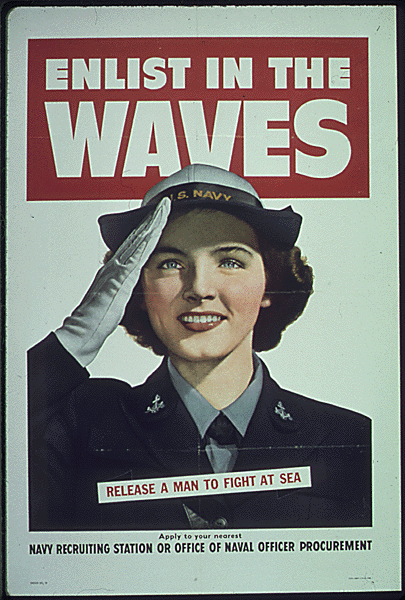
When the tides of World War II swelled, an unprecedented wave of women stepped forward to serve their country, becoming an integral part of the U.S. Navy through the Women Accepted for Volunteer Emergency Service (WAVES) program. This initiative not only marked a pivotal moment in military history but also set the stage for the transformation of women's roles in the armed forces and society at large. The WAVES program, initiated in 1942, was a beacon of change, showcasing the strength, skill, and patriotism of American women during a time of global turmoil.

The inception of WAVES was a response to the urgent need for additional military personnel during World War II. With many American men deployed overseas, the United States faced a shortage of skilled workers to support naval operations on the home front. The WAVES program was spearheaded by figures such as Lieutenant Commander Mildred H. McAfee, the first woman commissioned as an officer in the U.S. Navy. Under her leadership, WAVES members were trained in various specialties, including communications, intelligence, supply, medicine, and logistics, proving that women could perform with as much competence and dedication as their male counterparts.
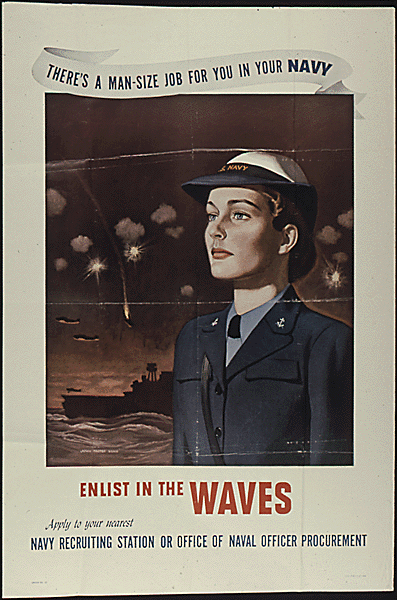
The impact of the WAVES program extended far beyond the war effort. Throughout their service, WAVES members faced and overcame significant societal and institutional challenges. At the time, the idea of women serving in the military was met with skepticism and resistance; however, the exemplary service of the WAVES shattered stereotypes and demonstrated the invaluable contributions women could make in traditionally male-dominated fields. Their work during the war not only contributed significantly to the Allies' victory but also laid the groundwork for the integration of women into the regular armed forces.

The legacy of the WAVES program is a testament to the courage and determination of the women who served. Their contributions went largely unrecognized for many years, but the program's impact on military and gender norms has been profound. The WAVES paved the way for future generations of women in the military, demonstrating that service and sacrifice know no gender. Today, women serve in all branches of the U.S. military, in roles ranging from combat positions to high-ranking officers, thanks in no small part to the trail blazed by the WAVES.


The WAVES program was more than just a wartime necessity; it was a watershed moment in the history of women's rights and military service. The women of WAVES not only supported the United States during a critical period but also propelled forward the conversation about gender equality in the armed forces and beyond. Their legacy is a reminder of the strength and resilience of women who rise to the challenge, breaking barriers and making waves in pursuit of a better world.
Read more: https://prologue.blogs.archives.gov/2023/11/06/historic-staff-spotlight-eunice-whyte-navy-veteran-of-both-world-wars/
208 notes
·
View notes
Text
Bayard Rustin
Back when I was working as an archivist at the American Jewish Historical Society at the Center for Jewish History in Manhattan, one of the most interesting figures I had the pleasure of learning about was proudly and publicly gay Civil Rights activist, advisor to Dr. Martin Luther King, and firm believer in the importance of Black and Jewish American communal solidarity: Bayard Rustin.

Bayard Rustin standing on a stage and speaking to a crowd from a podium at the 1967 NAACP Conference in Albany, New York. Image courtesy of the NMAAHC.
Check out the small, but fascinating collection here! The Schomburg Center for Research in Black Culture highly recommends this study of Mr. Rustin, and the NMAAHC has a fantastic bio here, with a link to further collections materials. I also highly recommend taking a look at some of the photos and related collections held by the Library of Congress.
As some of you may know, a well-received biopic of this fascinating figure was recently released. And incidentally, my dear friend and DC-based actor, Emily Gilson, had a small, but impactful role in the film as "Little Rock White Girl."
Check it out! Or at least, check out some of these fantastic collections.
99 notes
·
View notes
Text

Shogan Confirmed by U.S. Senate as 11th Archivist of the United States
Press Release: Wednesday, May 10, 2023
The United States Senate voted today to confirm Dr. Colleen Shogan as the 11th Archivist of the United States.
Nominated by President Biden on August 3, 2022, Shogan will begin her tenure as the head of the National Archives and Records Administration next week. She will be the first woman to hold the position permanently, succeeding David S. Ferriero, who retired in April 2022.
Most recently, Shogan served as Senior Vice President and Director of the David M. Rubenstein Center at the White House Historical Association. She previously worked in the United States Senate and as a senior executive at the Library of Congress. Shogan was the Vice Chair of the Women’s Suffrage Centennial Commission and the Chair of the Board of Directors at the Women’s Suffrage National Monument Foundation.
A native of the Pittsburgh area, Shogan holds a BA in Political Science from Boston College and a Ph.D. in American Politics from Yale University, where she was a National Science Foundation Graduate Fellow. She is a member of Phi Beta Kappa, the Order of the Cross and Crown, and the Literary Society of Washington, DC.
Press Release: https://www.archives.gov/press/press-releases/2023/nr23-31
Image: Dr. Colleen Shogan, courtesy of the White House Historical Association
48 notes
·
View notes
Photo
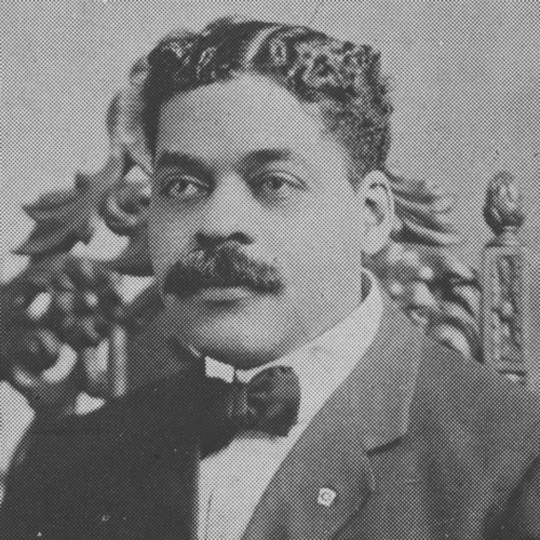



“We need the historian and philosopher to give us with trenchant pen, the story of our forefathers, and let our soul and body, with phosphorescent light, brighten the chasm that separates us. We should cling to them just as blood is thicker than water. American Negro must remake his past in order to make his future.”
...
Arturo Alfonso Schomburg, collector, archivist, writer, activist, and important figure of the Harlem Renaissance was born in San Juan, Puerto Rico on January 24, 1874. His mother was a black woman originally from St. Croix, Danish Virgin Islands (now the U.S. Virgin Islands), and his father was a Puerto Rican of German ancestry.
Seventeen-year-old Schomburg migrated to New York City in 1891. Very active in the liberation movements of Puerto Rico and Cuba, he founded, in 1892, Las dos Antillas, a cultural and political group that worked for the islands’ independence from Spain. After the collapse of the Cuban revolutionary struggle, and the cession of Puerto Rico to the United States, Schomburg, disillusioned, turned his attention to the history and culture of Africa and what we know today as the African Diaspora.
In 1911, as its Master, he renamed El Sol de Cuba #38, a lodge of Cuban and Puerto Rican immigrants, as Prince Hall Lodge in honor of the first African American freemason. The same year, he founded, with journalist John Edward Bruce, the Negro Society for Historical Research which gathered African, Caribbean, and African American scholars. In 1922 he was elected president of the American Negro Academy.
Schomburg firmly believed that “The American Negro must remake his past in order to make his future.” The first part of this process was to reclaim history by evidencing Black people’s contributions to history and culture. Working as a mailroom supervisor at a Brooklyn bank, Schomburg spent his free time and resources, and his retirement after 1930, collecting materials on Africa and its Diaspora. He traveled through the United States, Europe, and Latin America, amassing over 10,000 books, manuscripts, sheet music, photographs, newspapers, periodicals, pamphlets, and artwork.
The second phase of Schomburg’s project was to bring this knowledge to the public. He lent numerous items to schools, libraries, and conferences and organized exhibitions. He wrote articles for a diversity of publications: Marcus Garvey’s Negro World; the NAACP’s The Crisis edited by W. E. B. Du Bois; The Messenger, founded by Socialists A. Philip Randolph and Chandler Owen; the organ of the National Urban League, Opportunity; and Harlem’s newspaper, The Amsterdam News.
In 1926 the Carnegie Corporation bought Schomburg’s collection for $10,000 (about $125,000 today) on behalf of The New York Public Library. The collection was added to the Division of Negro Literature, History and Prints of the Harlem branch on 135th Street.
From 1929 to 1932 Schomburg worked as a curator at Fisk University’s library and was instrumental in expanding its collection from 100 to 4,600 items. Back in New York, he was appointed curator of The New York Public Library’s Harlem Division. He held the position until his death on June 10, 1938 in Brooklyn. He was 64. In his honor, the Division was renamed the Schomburg Collection of Negro Literature, History and Prints in 1940. Arturo Schomburg’s enduring legacy was further acknowledged when the Collection became the Schomburg Center for Research in Black Culture of The New York Public Library in 1972. With over 11 million items, it is one of the world’s foremost research centers on Africa and the African Diaspora.
Legendary.
71 notes
·
View notes
Text

"The American Negro must remake his past in order to make his future."
This summer, let us browse the stacks of the remarkable life and career of archivist, collector, and curator Arturo Alfonso Schomburg (the "Father Of Black History"), without whom there almost certainly would not have been a Harlem Renaissance. Born in 1874 Puerto Rico to a black mother (from the Virgin Islands) and a Puerto Rican father of German ancestry (hence his distinctive surname), Schomburg recounted a childhood tale of a bigoted grade school teacher in San Juan, who asserted that black people had "no history, art or culture." He moved to New York City in his teens but he never forgot this racist sentiment, and he remained fiercely connected to his Puerto Rican heritage. Activism called to Arturo early; in 1892 he was deeply involved with Las Dos Antillas, an advocacy group that pushed for Puerto Rican independence from Spain --a mission which of course sputtered to a disillusioning end after Spain ceded Puerto Rico to the United States.
Schomburg pivoted to academic life and embarked on a study of the African Diaspora. In 1911 he co-founded the Negro Society for Historical Research, a long-term reclamation project in which materials on Africa and its Diaspora were collected. Schomburg would devote the next 20 years of his life to this project --travelling throughout the United States, Europe, and Latin America to rare book stores, antique dealers, and even used furniture stores (one from which he apocryphally claimed to have recovered a handwritten essay by Frederick Douglass). Over time he and his team of African, Caribbean, and African American scholars would amass a collection of over 10,000 books, manuscripts, artwork, photographs, newspapers, periodicals, pamphlets, and even sheet music. One of his proudest finds was a long-forgotten series of poems by Phillis Wheatley.
Of course as any curator will tell you, acquiring unique pieces is nothing without a means to share the knowledge and the history that comes with them --by 1930 (the year of his eventual retirement), Schomberg would have lent numerous items to schools, libraries, and conferences and organized exhibitions. In the midst of all this he wrote articles for a wide range of publications, to include Marcus Garvey's Negro World; the NAACP's The Crisis (edited by W. E. B. Du Bois), and A. Philip Randolph and Chandler Owen's The Messenger; as well as essays for the National Urban League and The Amsterdam News (Harlem's newspaper).
Significantly in 1926 the Carnegie Corporation bought Schomburg's collection for $10,000 (about $125,000 in today's currency), on behalf of The New York Public Library. The collection was added to the Division of Negro Literature, History and Prints of the Harlem Branch on 135th Street, of which Schomburg would later be appointed curator (following a stint as curator of the Negro Collection at Fisk University). The Division became the "go-to" centerpiece of many a Black artist, writer, and scholar; to include Arna Wendell Bontemps and Zora Neale Huston. After his death in 1938, the Division was renamed the Schomburg Collection of Negro Literature, History and Prints. Schomberg's protégé, an up-and-coming author and poet named Langston Hughes, assumed responsibility for the collection.
Today the collection is known as the Schomburg Center for Research in Black Culture (still under the auspices of The New York Public Library) --now topping out at more than 11 million indexed items, and considered to be one of the world's foremost research centers on Africa and the African Diaspora.
#blacklivesmatter#dothework#teachtruth#history detective#new york public library#arturo alfonso schomburg#harlem renaissance
27 notes
·
View notes
Text
Books that should be inducted into Coquette 'Girlblogger' Canon

The Color Purple by Alice Walker
A powerful cultural touchstone of modern American literature, The Color Purple depicts the lives of African American women in early twentieth-century rural Georgia. Separated as girls, sisters Celie and Nettie sustain their loyalty to and hope in each other across time, distance and silence. Through a series of letters spanning twenty years, first from Celie to God, then the sisters to each other despite the unknown, the novel draws readers into its rich and memorable portrayals of Celie, Nettie, Shug Avery and Sofia and their experience. The Color Purple broke the silence around domestic and sexual abuse, narrating the lives of women through their pain and struggle, companionship and growth, resilience and bravery. Deeply compassionate and beautifully imagined, Alice Walker's epic carries readers on a spirit-affirming journey towards redemption and love.

Plum Bum: A Novel Without Moral by Jessie Redmon Fauset
Written in 1929 at the height of the Harlem Renaissance by one of the movement's most important and prolific authors, Plum Bun is the story of Angela Murray, a young black girl who discovers she can pass for white. After the death of her parents, Angela moves to New York to escape the racism she believes is her only obstacle to opportunity. What she soon discovers is that being a woman has its own burdens that don't fade with the color of one's skin, and that love and marriage might not offer her salvation.

Comfort Woman by Nora Okja Keller
Comfort Woman is the story of Akiko, a Korean refugee of World War II, and Beccah, her daughter by an American missionary. The two women are living on the edge of society—and sanity—in Honolulu, plagued by Akiko's periodic encounters with the spirits of the dead, and by Beccah's struggles to reclaim her mother from her past. Slowly and painfully Akiko reveals her tragic story and the horrifying years she was forced to serve as a "comfort woman" to Japanese soldiers. As Beccah uncovers these truths, she discovers her own strength and the secret of the powers she herself possessed—the precious gifts her mother has given her.
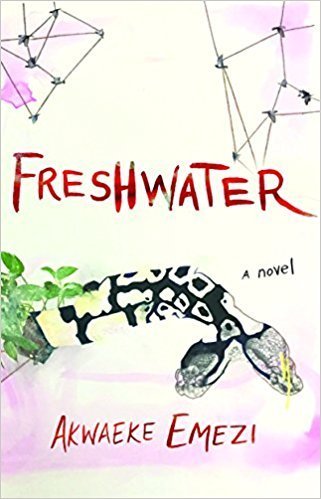
Freshwater by Akwaeke Emezi
Ada begins her life in the south of Nigeria as a troubled baby and a source of deep concern to her family. Her parents, Saul and Saachi, successfully prayed her into existence, but as she grows into a volatile and splintered child, it becomes clear that something went terribly awry. When Ada comes of age and moves to America for college, the group of selves within her grows in power and agency. A traumatic assault leads to a crystallization of her alternate selves: Asụghara and Saint Vincent. As Ada fades into the background of her own mind and these selves--now protective, now hedonistic--move into control, Ada's life spirals in a dark and dangerous direction.
Told from the perspective of the various selves within Ada, and closely based on the author's own personal experiences, Freshwater explores the metaphysics of identity and mental health, plunging the reader into the mystery of being and self. Freshwater dazzles with ferocious energy and serpentine grace, heralding the arrival of a fierce new literary voice.
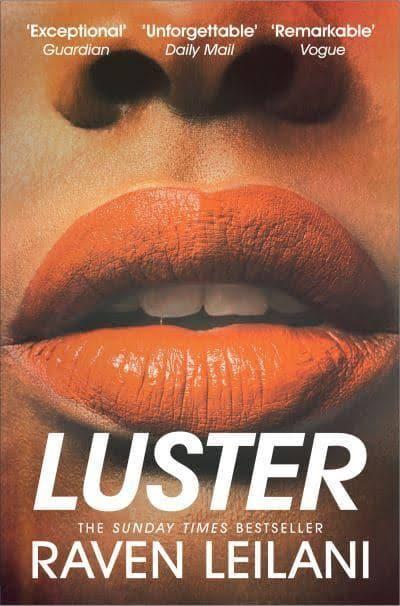
Luster by Raven Lelani
Edie is just trying to survive. She’s messing up in her dead-end admin job in her all-white office, is sleeping with all the wrong men, and has failed at the only thing that meant anything to her, painting. No one seems to care that she doesn’t really know what she’s doing with her life beyond looking for her next hook-up. And then she meets Eric, a white middle-aged archivist with a suburban family, including a wife who has sort-of-agreed to an open marriage and an adopted black daughter who doesn’t have a single person in her life who can show her how to do her hair. As if navigating the constantly shifting landscape of sexual and racial politics as a young black woman wasn’t already hard enough, with nowhere else left to go, Edie finds herself falling head-first into Eric’s home and family.

Brunt Sugar by Avni Doshi
In her youth, Tara was wild. She abandoned her loveless marriage to join an ashram, endured a brief stint as a beggar (mostly to spite her affluent parents), and spent years chasing after a dishevelled, homeless 'artist' - all with her young child in tow. Now she is forgetting things, mixing up her maid's wages and leaving the gas on all night, and her grown-up daughter is faced with the task of caring for a woman who never cared for her.
This is a love story and a story about betrayal. But not between lovers - between mother and daughter. Sharp as a blade and laced with caustic wit, Burnt Sugar unpicks the slippery, choking cord of memory and myth that binds two women together, making and unmaking them endlessly.

Dogs of Summer by Andrea Abreu
High in the mountains of northern Tenerife, the sun hides behind a seemingly endless ceiling of cloud cover that traps the region's inhabitants in an abject, infernal heat. There, in a ramshackle village far from the island's glamorous beach resorts, two adolescent girls pass a treacherous summer in each other's all-consuming company.
The nine-year-old narrator is known to us only as Shit - a pet name given to her by her best friend Isora. Blonde, brash, beautiful Isora, who isn't afraid to mock the boys around town or gossip with the adults; who, though she is only one year older, has already grown breasts and pubic hair. Together, Shit and Isora wander the streets, shooing away the neighborhood's many pitiful dogs; they try to keep skinny by vomiting up sweets; they dream of shiny BMWs that will take them down to the beach, where they will finally get to enjoy the sea, just like the tourists whose vacation homes Shit's mother cleans for a living. But as June turns to July, and July to August, the narrator's simmering love for her friend erupts into a painful sexual awakening, just as Isora begins to heed the first calls of womanhood. Shit tries to keep up with her, but learns that growing up is a path one must walk alone; a journey so solitary, it can lead even the most intimate friendships to violent ends.

Ugly Girls by Lindsay Hunter
Perry and Baby Girl are best friends, though you wouldn’t know it if you met them. Their friendship is woven from the threads of never-ending dares and power struggles, their loyalty fierce but incredibly fraught. They spend their nights sneaking out of their trailers, stealing cars for joyrides, and doing all they can to appear hard to the outside world.With all their energy focused on deceiving themselves and the people around them, they don’t know that real danger lurks: Jamey, an alleged high school student from a nearby town, has been pining after Perry from behind the computer screen in his mother’s trailer for some time now, following Perry and Baby Girl’s every move—on Facebook, via instant messaging and text,and, unbeknownst to the girls, in person. When Perry and Baby Girl finally agree to meet Jamey face-to-face, they quickly realize he’s far from the shy high school boy they thought he was, and they’ll do whatever is necessary to protect themselves.

Jesus Saves by Darcey Steinke
Jesus Saves , a New York Times Notable Book of the Year, is a chilling horror story, a suburban gothic set not among green manicured lawns and cul-de-sacs, but the trash-filled woods between subdivisions and superhighways and the strip malls and duplexes on the back side of town. It’s the story of two Ginger, a troubled minister’s daughter; and Sandy Patrick, who was abducted from summer camp and now smiles from missing-child posters all over town. Layering the dreamscapes of Alice in Wonderland with the subculture of River’s Edge , Darcey Steinke’s Jesus Saves is an unforgettable passage through the depths of literary imagination.

Cats Eye by Margaret Atwood
Cat's Eye is the story of Elaine Risley, a controversial painter who returns to Toronto, the city of her youth, for a retrospective of her art. Engulfed by vivid images of the past, she reminisces about a trio of girls who initiated her into the fierce politics of childhood and its secret world of friendship, longing, and betrayal. Elaine must come to terms with her own identity as a daughter, a lover, and artist, and woman—but above all she must seek release from her haunting memories. Disturbing, hilarious, and compassionate, Cat's Eye is a breathtaking novel of a woman grappling with the tangled knots of her life.
7 notes
·
View notes
Text
Frontier myth vilified the California grizzly. Science tells a new story. (Washington Post)

The grizzly, a subspecies of brown bear, has long held a place in mainstream American myth as a dangerous, even bloodthirsty creature. Its scientific name, Ursus arctos horribilis, means “the horrible bear.” But that image is being challenged by a new set of studies that combine modern biochemical analysis, historical research and Indigenous knowledge to bring the story of the California grizzly from fiction to fact.
In January, a team of experts led by University of California at Santa Barbara ecologist Alexis Mychajliw published a paper in the Proceedings of the Royal Society B about the diet of the California grizzly bear and how that influenced its extinction. The results challenge virtually every aspect of the bear’s established story.
“Pretty much everything that I thought I knew about these animals turned out to be wrong,” said Peter Alagona, an ecologist and historian at UCSB and co-author of the study.
Much of the grizzly bear’s long-standing narrative comes from stories, artwork and early photographs depicting California grizzlies as huge in size and aggressive in nature. Many of these reports, which found wide readership in newspapers elsewhere in the West and in the cities back East, were written by what Alagona calls the Californian influencers of their time.
“They were trying to get rich and famous by marketing themselves as these icons of the fading frontier,” Alagona said. “A lot of the historical sources that we have about grizzlies are actually not about grizzlies. They’re about this weird Victorian 19th-century celebrity culture.”
The team of ecologists, historians and archivists compared the image of California grizzlies from these frontier reports to harder data in the form of bear bones from museum collections all over the state.
The frontier myth had painted the California bears as larger than grizzlies elsewhere in the country, but the bone analysis revealed that they were the same size and weight, about 6 feet long and 440 pounds for the average adult.
In an even larger blow to the popular story of the vicious grizzly, the bones showed that before 1542, when the first Europeans arrived, the bears were only getting about 10 percent of their diet from preying on land animals. They were primarily herbivores, surviving on a varied diet of acorns, roots, berries, fish and occasionally larger prey such as deer.
As European-style farming and ranching began to dominate the landscape, grizzlies became more like the stories those frontier influencers were telling about them. The percentage of meat in their diet rose to about 25 percent, probably in large part because of the relative ease of catching a fenced-in cow or sheep compared to a wild elk.
Colonialism forced so many changes on the California landscape so quickly, affecting every species that the bears ate and interacted with, that the exact cause of this change will be difficult to ever fully understand.
Still, grizzlies were never as vicious or purely predatory as the stories made them out to be. The narrative of the huge killer bear instead fed a larger settler story of a landscape — and a people — that could not coexist with the settlers themselves. And that story became a disaster for more than just bears.
Although we will never have exact numbers, experts agree that hundreds of thousands of Indigenous people were living in what is now California before White settlers arrived. One frequently cited estimate puts the population at 340,000.
By 1900, that number had been slashed by more than 95 percent to around 16,000 surviving tribal members throughout the state. Eliminating the bear and the vast majority of California’s Indigenous people can be seen as parts of the same concerted effort to replace one landscape — and one set of stories — with another.
“The annihilation of the California grizzly bear was part of a much larger campaign of annihilation,” Alagona said. “I think it’s clear that what happened in California meets the legal definition of a genocide. But in a way, it was even more than that, because these were not just attempts to eliminate groups of people. These were attempts to destroy an entire world.”
6 notes
·
View notes
Text
Hiring Librarians Podcast S01 E07: Kaetrena Davis Kendrick (Part Two of Two)
My guest is Kaetrena Davis Kendrick, whose work on low morale in libraries is lighting some dark corners in the LIS profession.
My guest is Kaetrena Davis Kendrick, whose work on low morale in libraries is lighting some dark corners in the LIS profession. Her data collection projects and the associated reports are available on her Renewals website, as well as information about her coaching, facilitating and speaking, and consulting services. In this episode, I also mention her appearance on the Skillset podcast. You can…
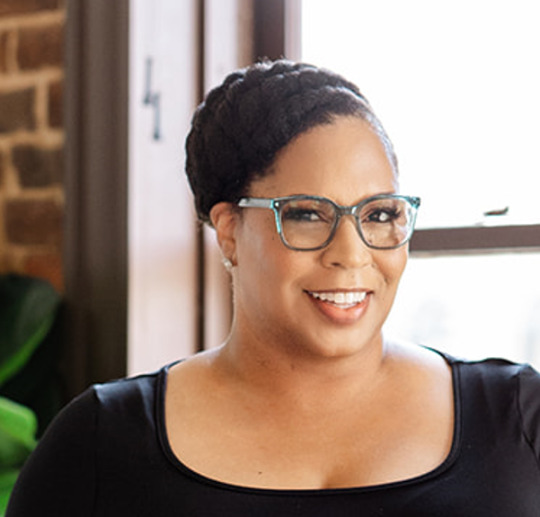
View On WordPress
#Librarian#librarians#libraries#library careers#library hiring#library interview#library jobs#LISCareers#Society of American Archivists
1 note
·
View note
Text
"Stuck in that amulet": From artifact to Crown Princess [Part 3]
Continued from part 2

Elena trapped inside the amulet as shown in the film, Elena and the Secret of Avalor
Coming back to the amulet, it bestows power on those who wear it, it stores magic, but cannot be a weapon. Even more significant is the fact that if the amulet had been destroyed before Sofia had freed Elena, she would have died! The amulet also can curse those who do bad deeds. Reportedly, it is famous among those who practice magic in the interconnected world of Elena of Avalor and Sofia the First. It has a bit of a provenance as well, specifically created in the Kingdom of Maru (akin to the Aztecs or Mayans perhaps), an ancient civilization that disappeared before the Kingdom of Avalor came about.
Reprinted from my Wading Through the Cultural Stacks WordPress blog. Originally published on Mar 15, 2023.
Unlike the magical mirror in Steven Universe, the amulet more directly fulfills the definition of an artifact in the Dictionary of Archives Terminology: "a physical object that is made or modified by human culture." More than that, the amulet is something tangible, as it obviously has "significant depth relative to its height and width", i.e., an object. It is not, however, a specimen nor a resource or an item. Hence, there are specific ways to preserve it and ensure it is not damaged. Over its history, it was passed down through royals until it reached Sofia, becoming her birthday present, and Elena even let her keep it as a sign of gratitude for saving her from the amulet.
Some have claimed that certain amulets have a "soul" or internal energy, noting that it is "important what material the amulet is made of, what kind of stones it is incrusted with" along with what signs and symbols. [4] Historically, the Egyptians believed that amulets would protect a mummified person after death. Others have stated that amulets, and talismans, were the "ultimate power players" in the ancient world, by "summoning protection". The amulet I'm discussing in this article is a fire opal, and originally red, becoming purple when she wore it. The word opal, itself, comes from the Latin words "opalus" or "opalius" in Greek, meaning precious stone, while a fire opal is named after fire, meaning a "fiery spirit and energy". It has also been associated with good luck, love, healing, calm, wealth, creativity, and amplifying feelings, depending on the culture. Compare this to a purple opal which seems to "increase...one’s mental capacity as a whole", while opals can also be "highly favored as a symbol of hope and purity". [5]
Otherwise, There isn't much else to say because the amulet doesn't really have much of a role in the show proper (Elena of Avalor) other than giving her magical powers, allowing to use the Scepter of Light, first shown in the episode "Scepter of Light". The scepter allows her to channel the magical powers given to her by being in the amulet. So, that's a positive from being stuck in an amulet for over 40 years! If her amulet had been stored usually, it would be in a special collections. Anyway, as always, comments and suggestions are welcome.
© 2022 Burkely Hermann. All rights reserved.
Notes
[4] For this, see "Spiritual amulets – The most consistent protection tool", a page on a website calling itself Spellcaster Maxim, run by a person who describes themselves as an esoteric, astrologer, and writer.
[5] See Minikin, Tracey. "The Powerful Legacy of Talismans and Amulets in Modern Society." Veranda, Jun. 29, 2020; Smith, Olivia. "Fire Opal Meanings, Properties and Uses." Crystal Stones, Nov. 3, 2021; "Purple Opal (Morado Opal)." Crystal Council. Accessed Sept. 1, 2022; "Purple Opal Meaning and Properties." Emoche. Accessed Sept. 1, 2022.
#elena of avalor#amulet#archivy#tv films#steven universe#egypt#archival science#archival studies#preservation#special collections#definitions#society of american archivists#artifacts#pop culture#reviews#aimee carrero
4 notes
·
View notes
Note
I recently saw a post you made talking about working as an archivist. I was wondering, where should I look to submit documents to an archive? I have a pile of journals I've kept over my life, and I have the vague idea of submitting it posthumously to any historian that would take it. I live in the mid-USA, if that makes a difference. Thank you for your time.
Ok, the answer to this question is "it depends". It depends on you and what your journals document and where you live and a bunch of things only you can answer.
The basic steps I would suggest are, think about what kind of person/historian would be interested in your journals, given who you are and what kind of material your journals include. Here are a few examples:
You are a member of a particular minority group and you write about your experiences as someone who is Latino/black/Arab-American/Jewish/LGBTQ/disabled/etc etc. Look for an archive that specializes in that group. Doesn't matter if they are geographically local to you, if you have a collection that interests them, they'll make sure it reaches them.
You hold specific religious or political beliefs that are documented in your journals, e.g. you are a card-carrying socialist or you're a practicing Quaker or you're very involved in environmental activism, or whatever. Again, look for an archive that collects that kind of material, doesn't matter if they're geographically close to you, they'll likely be willing to make it work for an interesting collection.
You are a member of a specific profession and your education and/or day-to-day work practices are documented in your journals. If you work for a large institution (such as a university, a hospital, a government body, a major corporation) they may have an archive that would consider accepting your journals. If you belong to some professional organization or union, likewise they might have an archive that would be interested.
Maybe none of those things apply, but you've lived in your specific geographic area for a long time and your journals have information about interesting events in your town's history or how your local community has changed over the years. Look for whatever your community has in the way of a local history society - it might be at the town or county level, or if you're in a big enough city there might be subsections for various specific districts/neighbourhoods. It might be based out of your local library, or a local history museum, or it might have its own independent existence. Even if they don't have a fully-fledged separate archive, they might accept a donation that's relevant to the local area.
Basically what I'm saying is, figure out who you think your journals would be useful to, and then figure out if that group or organization has an archive, or if there's an archive that specifically specializes in collecting that kind of material. Some large archives serve multiple functions - for instance, the Reuther Library in Detroit is the institutional archive for Wayne State University, but also collects materials about Detroit history, and also collects materials about labour and union history from other areas. Smaller archives tend to specialize in a much more narrow area.
The other thing is, I'd very much encourage you to work on this before you die. Shop around if you need to - you might not find the perfect place or ideal person to work with on your first shot. Some places will be overworked and understaffed and will say no unless it's the most perfect collection known to humanity. Some might place requirements on a donation that you don't agree with. So take a bit of time and look around and find someplace you're comfortable with.
And then, once you find a place, most crucially, while you're still alive, you can work with an archivist to help identify and document your collection. This is speaking from personal experience: receiving a collection from someone who is dead is always going to be a less fruitful experience than getting one from someone who is alive and can explain to me what something is or what it means to them or who are the people in this picture. Why does this box have a wax model of a foot in it? Is this a human tooth? Why do you have this? There's crucial context that is lost when the person who created the thing or collected the thing is no longer around to explain it. So ideally, you would be around to do that kind of helping make sense of things that are confusing.
I hope that helps!
19 notes
·
View notes
Text
What's the password?
The Prohibition Era (1920-1933) was enacted through the 18th Amendment to the U.S. Constitution, which prohibited the "manufacture, sale, or transportation of intoxicating liquors."
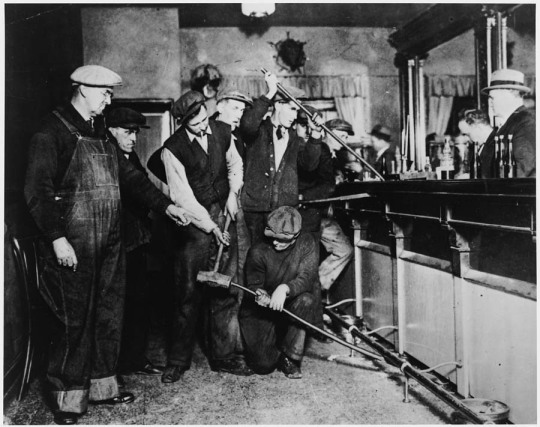
The movement to prohibit alcohol in the United States can be traced back to the early 19th century, when groups such as the Women's Christian Temperance Union and the Anti-Saloon League began advocating for the temperance movement. These groups argued that alcohol was a destructive force in society and that its production and sale should be prohibited.
Speakeasies, so named because patrons were supposed to speak quietly about them to avoid attracting attention from the authorities, flourished during the Prohibition Era. Speakeasies filled the demand for alcohol by providing a place for people to drink and socialize, often in secret. They could be found in cities and towns across the country and ranged from small, makeshift operations to elaborate, high-end establishments.

To get into a speakeasy, one often needed to know the password or knock on the door in a certain way. Once inside, patrons could purchase illegal alcohol, often at inflated prices. Speakeasies were often owned and operated by organized crime groups, who saw the Prohibition Era as an opportunity to make a profit.
While the Prohibition Era is often remembered as a time of speakeasies and bootlegging, it also had significant social and economic impacts. The ban on alcohol led to the rise of organized crime, as illegal production and sale of alcohol became a lucrative business for criminal organizations. It also led to widespread corruption and the undermining of the rule of law, as law enforcement officials were often bribed to look the other way.
Despite these negative consequences, the Prohibition Era had its supporters. Many saw it as a way to reduce crime and improve public health and morality. However, as the economic impacts of the ban became more apparent, support for Prohibition began to wane.
The end of Prohibition came in 1933 with the passage of the 21st Amendment, which repealed the 18th Amendment and once again legalized the manufacture, sale, and transportation of alcohol.
Read about how the Prohibition Era led to a rise in organized crime: Prohibition and the Rise of the American Gangster and Gangsters, G-Men, and Archivists.
Image 1: Photograph of Prohibition Agents Destroying a Bar; ca. 1920-1933; Records of the U.S. Information Agency, Record Group 306. (National Archives Identifier: 595674)
Image 2: Presidential Proclamation 2065 of December 5, 1933, in which President Franklin D. Roosevelt announces the Repeal of Prohibition., 12/05/1933 (National Archives Identifier: 299967)
47 notes
·
View notes
Note
I do have several questions about publishing serious non-fiction with a trade press...
My first question is affiliated, and is about whether you're still in academia or not. If you're not, I'd be interested in hearing how you go about your work - whether you have peer reviewers etc. and whether you know them from uni (either as classmates or professors) or not.
Secondly, how did you approach finding a press? Did you have a draft finished when you secured your deal, and what are the major differences a trade press versus university press request/demand?
I'm sorry for the load of questions by the way, I finished my MA degree in history (medieval) last year, I miss doing the research and writing, and you're really the first person I've seen online who has found a trade press. I considered asking you some of those questions before actually, so I kinda jumped on the chance with... much enthusiasm, lol.
First, affiliation. I ~identify~ as an independent scholar. However, as you know, connections and status mean everything in both academia and the publishing industry (and as an academic writing for a trade press, you have to demand respect from both), so I always make my credentials very clear:
MA in Modern Jewish History from the University of Maryland, thesis defended on first try with no revisions; I also name drop my adviser and certain committee members depending on who I'm talking to.
MLIS from the same institution, focus in Archival Science.
Seven year's employment as an archivist and content creator at the American Jewish Historical Society at the Center for Jewish History
Six figures of followers on social media
The combination of education, platform, and work experience is particularly important for convincing agents and publishers that you're a worthwhile investment.
In terms of reviewers, I networked with and cold emailed two well respected academics in my specific subfield(s), and just asked them if they'd be down to peer review my work. I will be paying them out of my own pocket. The press doesn't require this as, as far as they're concerned, I'm the expert; but it's something I require for myself. It's important that this book not simply present a strong, readable, gripping narrative, but that it's also accurate and rigorous.
Now on to your second question. For serious nonfiction the first step is to get a literary agent. Literary agents sign clients for non-fiction based on book proposal and ~two sample chapters. They neither want nor expect the entire manuscript at this point. The agent is the party who has the relationships with acquisitions editors at the major publishing houses.
Once an agent signs you, you do some editorial work together, if necessary, and then you go on submission. The "on sub" process is basically your agent doing a series of targeted sales pitches to acquisitions editors. If an acquisitions editor wants to buy the project, they will have to present it to their team(s), and argue in favor of investing in the project; ie, they have to convince potentially multiple teams that this project will make them money.
The book proposal is an incredibly weird, complex piece of writing, and I advise hiring an editor to work with you on this. The best editors/consultants for book proposals tend to be what I call "behind the scenes big shots." These are usually people with journalistic training, who ghostwrite for a lot of very big names. These editors do not come cheap. In fact, I paid for mine with a round of crowdfunding y'all helped me with a few years ago. If you're interested, I could potentially put you in touch with mine.
Now once the proposal is ready and you've workshopped your query letter, you need to do some heavy research and make a list of lit agents you think could be a good fit for your project. You should have an A List, B List, and C List, and send them out in batches of 5-10 to keep this manageable. I can answer further questions about this research process, if you'd like.
The getting-an-agent process is probably the hardest part. It took me five years to get from "Holy shit this is my book I'm gonna do a book," to "I have an agent and we're going on sub." It's HARD and you'll really be forced to reframe how you understand success and failure. Like, the first time I got a personalized rejection with feedback I fucking PARTIED. A personalized rejection is huge, and FEEDBACK, omg.
The big difference, is that for academic presses you need a PhD and a genuine intervention in the historiography. For trade press, you need to convince multiple parties that the project can sell, and that you're qualified to write it.
Now some candor: you have to be incredibly single-minded to push through this process. Like, to the point that you're willing to sacrifice your day job and let your health fall by the wayside. Which leads us to: privilege!
It's very difficult to be able to put all your single-minded energy behind this process if you a. are not independently wealthy; b. are not married to a person with a lot of money; or c. do not have well-off parents who are able to support you. I can honestly say that, if I were not in category c, the process would have been much slower; I'm not even sure if it would be happening yet.
My publisher's advance--which was generous for a first time, untested writer--over one year was enough to MAYBE cover my health insurance and my monthly storage unit; I also have two part time jobs. And that's it. My parents handle the rest [ETA: to clarify, I do live with them]. Publisher's advances are not something you can live on unless you already have clout, or fame. And if you have a one year deadline, your writing will be full time. I'm not telling you this to discourage you. Professionally I have found myself in many fields where the silent part is "we assume you have family/spousal wealth because lol no one can live on this amount of money." It's not okay and it pisses me the fuck off. I feel like, if I didn't make this clear, I'd be complicit in maintaining those structural inequalities. I don't know how to dismantle them (it's gonna take way more than one person) but saying the quiet part out loud is a start.
Anyway, hope I answered all your questions and also didn't discourage you! Also, you never need a reason to ask me about this stuff.
12 notes
·
View notes
Text
Recent books, fiction -
Shola von Reinhold, LOTE - essentially a black queer modernist Possession; I enjoyed it quite a lot. Mathilda, an erstwhile archivist and self-described "Arcadian" devotee of stylish queer figures from the early twentieth century follows the trail of a forgotten black woman modernist writer. I loved Mathilda as a narrator, her unapologetically sensuous engagement with the figures she studies and her embrace of pleasure and style and decadence as sites of both joy and resistance. Like Possession, this includes some razor-sharp and very funny parody of contemporary academic and artistic circles, this time directed mostly towards nihilistic post-modernists; von Reinhold's gaze is very clear on the actual costs of this kind of fantasized negation of the self. I found myself wanting a little more out of the ending in some ways, but over all I loved and definitely recommend this.
Rahul Mehta, Quarantine - [despite our current associations with the title, this book came out in 2011 and is not related to plague or pandemics at all] collection of short stories largely about young gay Indian-American men struggling with various types of feelings of disconnection. Elegantly written and engaging, but sometimes overly detached and repetitive. I would read more by this author.
Rainbow Rowell, Carry On - I think I read this because Jo Walton recommended it on Tor and I hadn't read anything by this author? Anyway, I shouldn't have. The novel is a tepid Harry Potter parody that ends up amounting to bad Harry/Draco fic in which Draco is a vampire. It was stupid and badly written, and I don't care nearly enough about Harry Potter from any angle to be interested. Not recommended, and I will not be trying anything else by this author.
Darry Gregory, We Are All Completely Fine - this is now the third book I have read which takes as its premise survivors of horror movie scenarios coming together in some way (the others were Riley Sager's Final Girls, which I didn't like much, and Grady Hendrix' The Final Girl Support Group, which I had a lot of fun with). I found this one quite moving, though limited by being a novella - there were a lot of problems, especially with the denouement, that I think could have been easily solved in a longer book. Gregory's wife is a therapist (he thanks her in the acknowledgements), and so the therapy group in which all the characters meet is written a lot more believably than most group therapy in fiction (though I would make some different choices than the facilitator!). I was quite moved by the thread throughout many of the characters' stories about their own ambiguous relationship to their various victimizations, the parts of the experiences they long for or miss, the unresolved questions about meaning-making. Some of the characters came off as more full people than others, which I put down to limited space; likewise, there's a (heavily foreshadowed) reveal at the end about the identity of the therapist which I thought could have worked but as it was felt rushed, particularly given the attention to therapeutic ethics earlier in the book. Recommended, though not for everyone.
Richard Wright, The Man Who Lived Underground - posthumously published novella expanding on a previously published short story of Wright's, which I have not read. A black man in Chicago is tortured while under arrest for a crime he did not commit; he subsequently flees into the city sewers, where he undergoes an existential shift in the experience of being proximate to but apart from human society. This was beautifully, vividly written; the sections describing our protagonist's solo journey through the sewers and the way he makes sense of what he hears and witnesses from the lives of the people around him will stay with me a long time. The novella is published with an autobiographical essay from Wright about his grandmother's religiosity, which inspired him to write the book; this essay was interesting in itself, but I felt that the novella stood well without it.
Emily Carroll, Through the Woods - collection of graphic gothic horror short stories (graphic like graphic novel, not graphic like explicit - unwieldy turn-of-phrase). Carroll's art is gorgeous, and I enjoyed it a lot despite graphic fiction not working well for me. The stories themselves are slight and often could use more development and explication, but I am still glad I read this. Very good to read on a rainy autumnal day with some tea, which is what I did.
Gaile Parkin, Baking Cakes in Kigali - Angel, a middle-aged Tanzanian cake baker now living and working in Kigali, Rwanda, runs her business while trying to be a decent person and support those in the community around her. This was a beautifully gentle, optimistic novel that held a lot of space for the complexity of Angel's social world and treats the moral choices she has to make her day-to-day life as worthy of serious consideration (her musings about under what circumstances she would take a moral stand of refusing to serve a customer was a good example). At some points throughout the book I was worried it would land too shallowly on serious topics, but it came through and won me over. And I loved hearing about how Angel sold her cakes.
Caroline McKenzie, A Year of Ugly - a family of undocumented Venezuelan immigrants living in Trinidad deal with a madcap series of adventures with blackmailers while a romance plot line happens in the foreground. I didn't like this; its humor felt cruel to me, and the tone in sections about sex work or the female characters' sexuality felt very sour. McKenzie has an author's note about she was trying to write about serious experiences of her community in a more light-hearted way, but the contrast with Baking Cakes in Kigali, which ostensibly had the same aim but handled it with gentleness and humanity, was stark. Not recommended.
V. C. Andrews, Flowers in the Attic - yes, I'd never read it before! It was at the library, and I thought it was finally time. It's a fascinating book - the use of detail which at once feels fetishistic while also reminding me of older children's novels (compare the Dollanganger children cleaning up the attic with the protagonists of The Boxcar Children in their titular makeshift home); the contained extremity of the gothic melodrama; the fantasmatic alternation of confinement and expansiveness in the use of space. I wouldn't say it's good, exactly, but I'm glad I read it. Probably won't read the sequels, but will be thinking about it for a long time.
23 notes
·
View notes